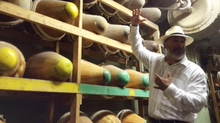Curious contraptions of yesterday's workplaces

BBC - Capital

If you’ve been in the workplace long enough, no doubt there’s a lengthy list of the technology you’ve cast aside.
Fax machines, pagers and copiers the size of a small car are all tools that were marvels of their time but have been replaced in the steady march of technical innovation.
Despite their obsolescence, there’s something we can learn from them, says Steven J. Hansman, a futurist and expert on emerging and past technologies.
Sometimes it’s about knowing when to act on a good idea, Hansman says. Other times it’s deciding to hold on to something that’s tried-and-tested instead of jumping on the newest gadget. Other times, it’s judging when an upgrade is in order.
Here are a few inventions that were once treasured, each one offering insight into the nature of the workplace and about how we work today.
An archaic solution to the open office?
StartFragment
EndFragment
StartFragment

In an era of open workplaces, where distractions are constant, many of us cope by donning a set of noise-cancelling headphones. But trying to avoid interruptions certainly isn’t a challenge unique to modern times.
Back in 1925, inventor and science fiction author Hugo Gernsback had an idea to block out annoying ambient noise: a contraption he called ‘the isolator’.
This helmet would shut out all sounds, smells, and sights of the outside world. The idea was that the user, looking through two small window holes in the metal hood, could concentrate only on the task right at hand.
Perhaps an idea that was just too far ahead of its time, the isolator never took off. But anyone who's suffered a bit of misophonia, or an emotional response to certain sounds, can identify with the need for a device that would drown out the surrounding world. Maybe the isolator could offer some relief.
A marker of changing culture
EndFragment
StartFragment

Fans of period dramas like Mad Men will recognise the dictation machine, a recording device used largely by heads of industry and their personal assistants. It was, in its era, a symbol of making it to the executive level.
“If you were important in the office, you didn’t have a typewriter on your desk,” Hansman says. “You had a Dictaphone, and you would never have dreamed of typing out your own letters.”
The Dictaphone got its start in 1881, produced by a company established by Alexander Graham Bell. It became widely used by business executives well into the 1970s, to record ideas, letters and memos to be transcribed onto paper. The very early machines recorded onto wax-coated cardboard cylinders and tape-based machines were introduced in the 1970s.
By the 1980s, the secretarial pool had largely disappeared, as workplaces that were once divided soon became more integrated. Without it, everyone from receptionists to top executives wrote their own memos on word processors and then computers, rendering the Dictaphone obsolete.
The Dictaphone serves to illustrate how cultural changes can render technology obsolete. “It used to be that technology was gradually replaced by new inventions or changes in culture that took many years,” Hansman says. “Now we replace things we just bought months ago.”
The missed opportunity of the Lambert Typewriter

A Frenchman who immigrated to America, Francoise Lambert was a serial tinkerer who rarely settled on one invention. But he stumbled on something in 1884 that had the potential to be huge – if only he’d gotten the timing right.
Lambert designed one of the world’s first typewriters, a machine that looks a bit bizarre nowadays, with a circular keyboard floating over a horizontal machine. It would likely have been a worldwide phenomenon if he had produced it right away, says John Neiheisel, an art and antique specialist with Everything But The House, an estate sales company in Cincinnati, Ohio in the US.
Instead, Lambert waited until after the turn of the century to manufacture it. By then, typewriters like the Underwood Standard had hit the market. Lambert’s clunky circular keyboard suddenly looked antiquated.
It’s a timeless lesson. Consider, for instance, Microsoft’s decision to enter the mobile phone business long after Apple and others cornered the market. While its phones earned favourable reviews, the company had captured just 1% of the global mobile market before the company was forced last year to cut 1,350 jobs from its phone division.
“Before it was actually produced, it was already defunct,” Neiheisel says of the Lambert. “This is really a machine that shows the importance of not missing your window.”
'The height of copying technology'
StartFragment

If you’re of a certain age, you might remember the mimeograph machine in your school office. Before the electronic copy machine replaced it in the 1980s, it produced paper duplicates using a roller that was hand-cranked or attached to a small motor. And for decades, it had been the height of copying technology.
“If you needed to make a lot of duplicates in a hurry, there were really no options but the mimeograph,” Hansman says.
Early prototypes emerged in the 1880s, but the design was perfected by 1900. By the ‘60s it was a fixture in offices and schools.
The photocopier produced by Xerox in 1959 eventually rendered the mimeograph obsolete. But unlike early copiers, Hansman says, the mimeograph rarely broke down. And it ran on refills of inexpensive ink – unlike those pricey copier cartridges we’re still bemoaning today.
Despite the fancy new technology provided by Xerox, early glitches showed there was a benefit to keeping a mimeograph around. There’s a certain parallel today: those who installed Windows 10 early, for instance, lived through glitches that disconnected the internet or froze webcams midstream. Those who waited found themselves with old operating systems that, just like the mimeograph, may have saved money and time – at least, until the new technology caught up.
One step up from an abacus
StartFragment
EndFragment
EndFragment
EndFragment

Ethan Vickery left university in 1995, full of knowledge on how to use computer software to crunch numbers. Instead, at his first job on a New York City trading desk, he found himself using a giant calculator that looked a century old.
The bond trade calculator in front of him traced its history to one produced in 1914 by the Monroe Calculating Machine Company. It could crunch numbers that Vickery needed regularly, like figuring out the yield maturity of bonds. But it was far from intuitive, requiring a precise order of numbers that could easily introduce an error.
“I had learned to do this on computers in software that was fairly easy to learn, and suddenly I’m stepping back in time,” Vickery says.
Vickery says his firm used the old calculators simply because they were slow to adapt to new technology. And if the mimeograph offers a moral in holding on to technology, the bond trader calculator is an example of the need to cast off the obsolete.
Eventually Vickery led a push in his office to replace the machines with software from Bloomberg, something that, by the early 2000s, had been done by most offices.
Vickery has left the bond trading industry and now sells real estate with Triplemint in New York, but occasionally he comes across an old bond trader calculator. “It does bring you back,” he says, “but not in a good way.”
StartFragment
Original article published: http://www.bbc.com/capital/story/20170518-curious-contraptions-of-yesterdays-workplaces
EndFragment





















